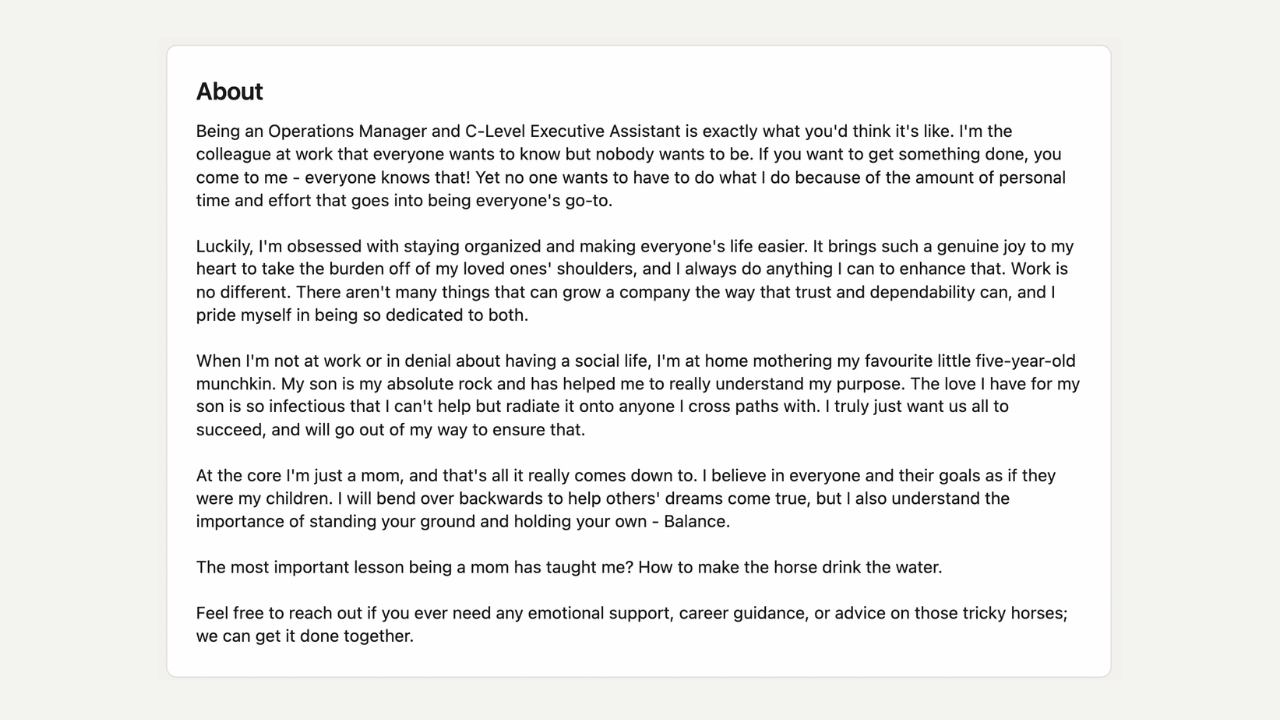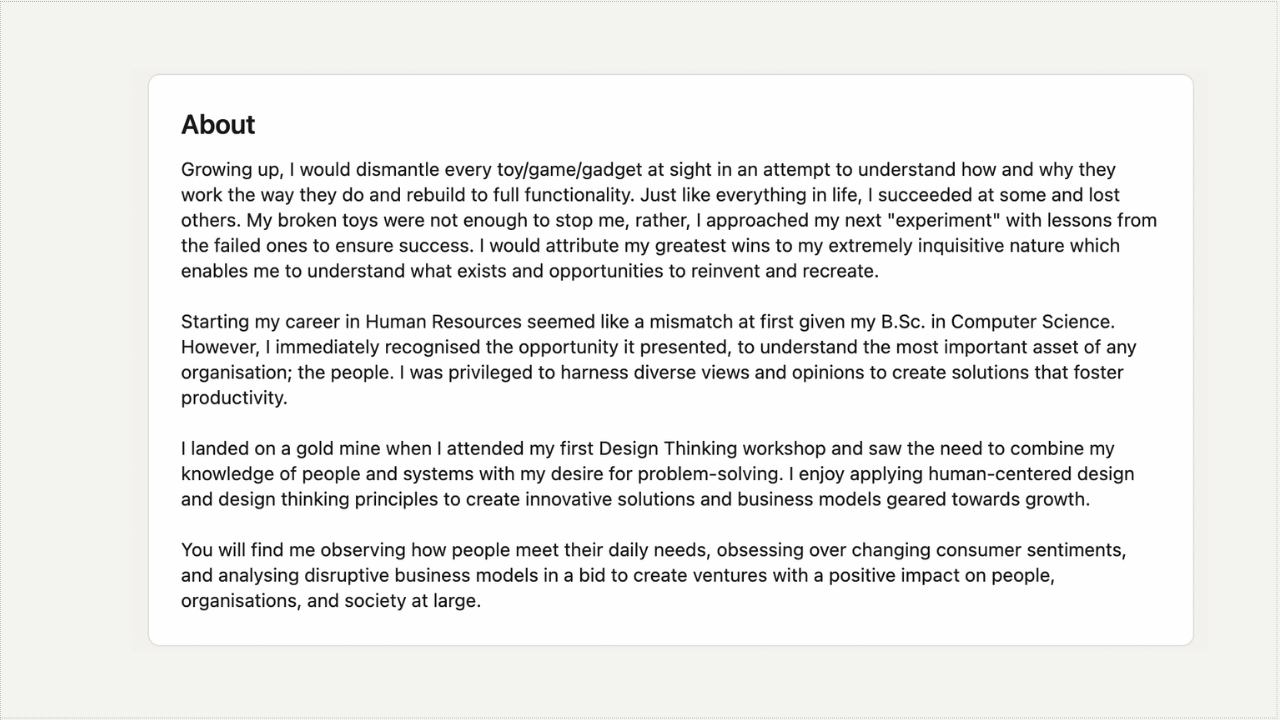A personal brand statement is a declaration of who you are, what you stand for, and what makes you different. It is the foundation of your personal brand and should be something you are known for.

A personal branding statement doesn’t necessarily have to be public facing. It can be something that you share with your team or keep private. But if you want to build a personal brand that differentiates you from the rest, you need a clear and concise statement that articulates what makes you different. It’s your north star. It’s the foundation for how you act, your attitude, and your work ethic.
I am a proponent that your brand statement should be public. It’s important for people, colleagues, hiring managers, recruiters, and industry peers to know what you stand for. It can live on your website, portfolio, or your LinkedIn profile.
Remember, your personal branding statement is your narrative. It is your story, an opportunity for you to tell the world about who you are and why it matters.
How to Write a Personal Brand Statement
A personal brand statement is a short story about your life as a student, professional and human being. It should include your values, passions, and interests. It should answer these three questions:
- Who are you?
- What do you stand for?
- Whys should others care?
When answering these questions, you should make a concerted effort to show passion and resolve. It needs to be like poetry. Not that it has to rhyme or anything like that. But when you read it out loud, it should elicit some emotion and capture their attention.
Saying something like, “Hi, I am Michael Brito, and I’m a senior at San Jose State University,” is what every other San Jose State University student is saying. You have to ask yourself, “What can I write that clearly defines who I am and what I do, but it’s different than everyone else?
You need to think creatively about how to answer that question differently.
Think about it this way: your personal brand statement is the promise you make to yourself and the world about who you are and what you stand for. It’s a way to hold yourself accountable to the standards you set for yourself. And it’s a way to differentiate yourself from everyone else.
When crafting your personal brand statement, it should be factual and accurate. However, it can also be written in a way that’s a future state. If you are an aspiring writer, it’s OK to talk about your passion for writing and what you plan to do in your future career.
Your statement can also be an ongoing or evergreen message. It will evolve and change over time as you get more experience in the industry or even if you change industries or career paths.
You must also use very targeted keywords within your personal branding statement. For example, if you want to get into digital marketing and that is your passion, you should use that language naturally throughout your statement.
You have to think holistically about the job that you want to do and what it entails. In addition to digital marketing, you might include things like social media marketing, content marketing, content strategy, and others. You will also want to include adjacent keywords related to your industry or your skills, including copywriting, analytics, and verbal and written communication skills.
This is especially important if you publish your brand statement on LinkedIn. Recruiters and hiring managers use highly targeted keyword searches when looking for candidates. You will not appear in the search results if you don’t have the keywords on your LinkedIn profile. When your profile is clicked on, your personal brand statement will be what triggers them to call you or connect with you directly.
It’s also important to note that a brand statement differs from a tagline or slogan. A tagline is a phrase that’s catchy and easy to remember. In my personal brand statement, the first sentence or two is what I use as my headline to get others to want to read more about who I am and what I stand for. Here’s the first line of my brand statement on my LinkedIn profile:
Digital OG. Building brands online since Al Gore invented the World Wide Web. 🌐
Personal Brand Statement Examples
I spent about 3 to 4 hours scouring my LinkedIn profile through first and secondary connections looking for a personal brand statement that I felt was impactful. I’d make a few suggestions, but this is one of the best personal brand statement examples I’ve seen in a long time. Here’s her complete LinkedIn profile.

I like how she blends her professional experience and aspirations with her love for her son and being a mom.
It is essential to balance what we do in our professional lives and what drives us as human beings. After all, we should be the same person at home as at work, within reason, of course. Many people have two distinct personas, one for work and one at home. And I think that’s OK. But the common denominator and our values and purpose should be reflected in both.
Similar to the above, this personal brand statement example reflects passion and purpose. It tells the story of someone who used to dismantle toys and gadgets and rebuild them as a child. And how that has turned into his love for design and how he applies it to his work today. It’s a great story. Here’s a link to his LinkedIn profile.

While these are just personal brand statement examples, yours should be unique and consistent with who you are, your values and purpose, and what you bring to the table.
Final Thoughts on Your Personal Branding Statement
Writing a personal branding statement is not easy. It took me six months to write mine, and I still don’t think it’s perfect. But that’s OK. A personal brand statement can be written and edited as often as you’d like.
As previously mentioned, I am a firm believer that your personal brand narrative should be public. I also believe that when you optimize your LinkedIn profile, your personal brand narrative should be reflective throughout the summary, headlines, job descriptions and more.
